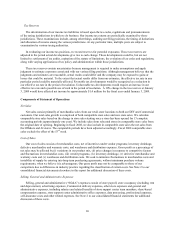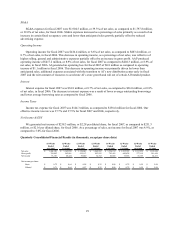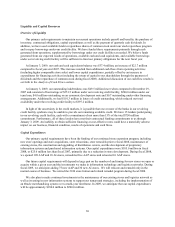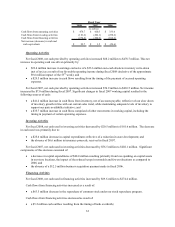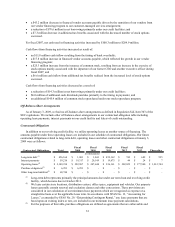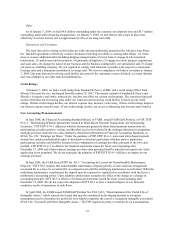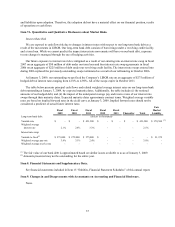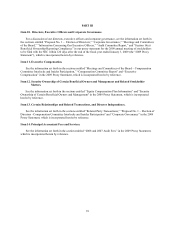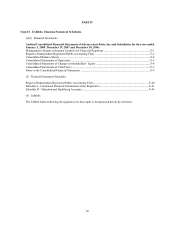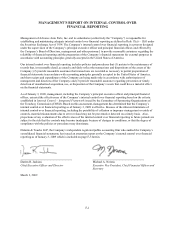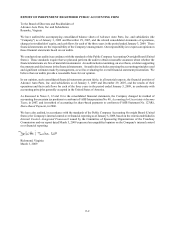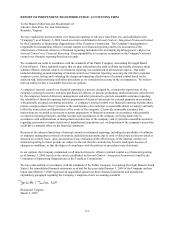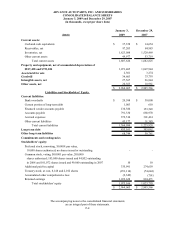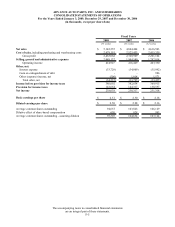Advance Auto Parts 2008 Annual Report Download - page 49
Download and view the complete annual report
Please find page 49 of the 2008 Advance Auto Parts annual report below. You can navigate through the pages in the report by either clicking on the pages listed below, or by using the keyword search tool below to find specific information within the annual report.35
Other
As of January 3, 2009, we had $4.0 million outstanding under an economic development note and $0.7 million
outstanding under other financing arrangements. At January 3, 2009, we had interest rate swaps in place that
effectively fixed our interest rate on approximately 60% of our long-term debt.
Guarantees and Covenants
The term loan and revolving credit facility are fully and unconditionally guaranteed by Advance Auto Parts,
Inc. Our debt agreements collectively contain covenants restricting our ability to, among other things: (1) create,
incur or assume additional debt (including hedging arrangements), (2) incur liens or engage in sale-leaseback
transactions, (3) make loans and investments, (4) guarantee obligations, (5) engage in certain mergers, acquisitions
and asset sales, (6) change the nature of our business and the business conducted by our subsidiaries and (7) change
our status as a holding company. We are required to comply with financial covenants with respect to a maximum
leverage ratio and a minimum consolidated coverage ratio. We were in compliance with these covenants at January
3, 2009. Our term loan and revolving credit facility also provide for customary events of default, covenant defaults
and cross-defaults to our other material indebtedness.
Credit Ratings
At January 3, 2009, we had a credit rating from Standard & Poor’s of BB+ and a credit rating of Ba1 from
Moody’s Investor Service, unchanged from December 29, 2007. The current outlook of Standard & Poor’s and
Moody’s is negative and stable, respectively, but does not affect our current credit ratings. The current pricing grid
used to determine our borrowing rates under our term loan and revolving credit facility is based on our credit
ratings. If these credit ratings decline, our interest expense may increase. Conversely, if these credit ratings improve,
our interest expense may decrease. If our credit ratings decline, our access to financing may become more limited.
New Accounting Pronouncements
In June 2008, the Financial Accounting Standards Board, or FASB, issued FASB Staff Position, or FSP, EITF
03-6-1, “Determining Whether Instruments Granted in Share-Based Payment Transactions Are Participating
Securities.” FSP EITF 03-6-1 addresses whether instruments granted in share-based payment transactions are
participating securities prior to vesting, and therefore need to be included in the earnings allocation in computing
earnings per share under the two-class method as described in Statement of Financial Accounting Standards, or
SFAS, No. 128, “Earnings per Share.” Under the guidance of FSP EITF 03-6-1, nonvested share-based payment
awards that contain nonforfeitable rights to dividends or dividend equivalents (whether paid or unpaid) are
participating securities and shall be included in the computation of earnings-per-share pursuant to the two-class
method. FSP EITF 03-6-1 is effective for financial statements issued for fiscal years beginning after
December 15, 2008 and all prior-period earnings per share data presented shall be adjusted retrospectively. Early
application is not permitted. We do not anticipate the adoption of FSP EITF 03-6-1 will have an impact on our
earnings per share.
In June 2008, the FASB Issued EITF No. 08-3, “Accounting by Lessees for Nonrefundable Maintenance
Deposits.” EITF 08-3 requires that nonrefundable maintenance deposits paid by a lessee under an arrangement
accounted for as a lease be accounted for as a deposit asset until the underlying maintenance is performed. When the
underlying maintenance is performed, the deposit may be expensed or capitalized in accordance with the lessee’s
maintenance accounting policy. Upon adoption entities must recognize the effect of the change as a change in
accounting principle. EITF 08-3 is effective for financial statements issued for fiscal years beginning after
December 15, 2008. We do not expect the adoption of EITF 08-3 to have a material impact on our financial
condition, results of operations or cash flows.
In April 2008, the FASB issued FASB Staff Position No. FAS 142-3, “Determination of the Useful Life of
Intangible Assets,” which amends the factors that must be considered in developing renewal or extension
assumptions used to determine the useful life over which to amortize the cost of a recognized intangible asset under
SFAS 142, “Goodwill and Other Intangible Assets.” The FSP requires an entity to consider its own assumptions



